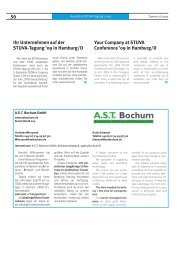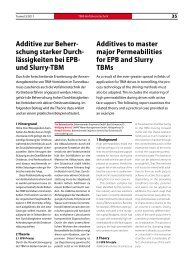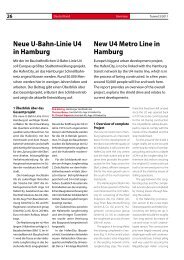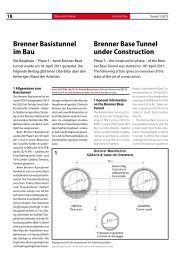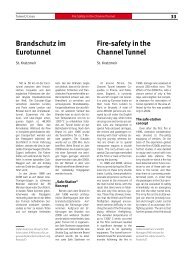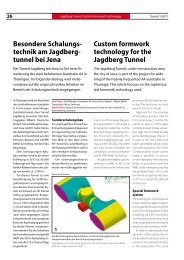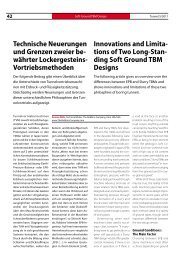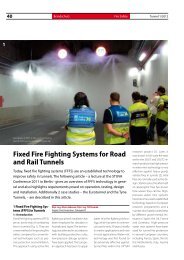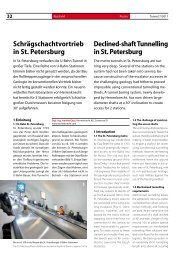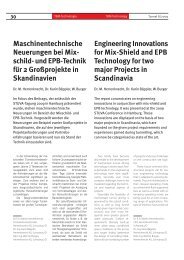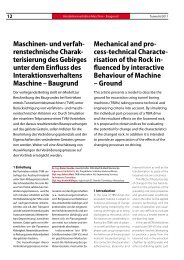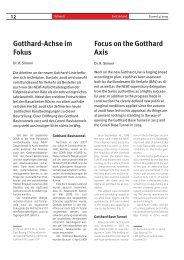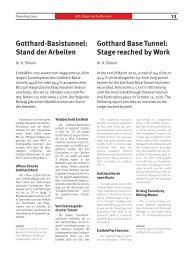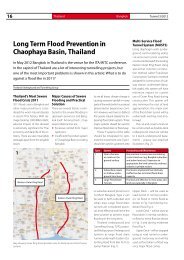Kaiser-Wilhelm-Tunnel: Von der Planung bis zur Ausführung Kaiser ...
Kaiser-Wilhelm-Tunnel: Von der Planung bis zur Ausführung Kaiser ...
Kaiser-Wilhelm-Tunnel: Von der Planung bis zur Ausführung Kaiser ...
Sie wollen auch ein ePaper? Erhöhen Sie die Reichweite Ihrer Titel.
YUMPU macht aus Druck-PDFs automatisch weboptimierte ePaper, die Google liebt.
<strong>Tunnel</strong> 1/2013<br />
<strong>Kaiser</strong>-<strong>Wilhelm</strong>-<strong>Tunnel</strong>: <strong>Planung</strong> <strong>bis</strong> Ausführung<br />
33<br />
mer Oberstadt mit teilweise<br />
nur 5 m Überdeckung unterfahren<br />
werden. Dies erfor<strong>der</strong>te<br />
neben <strong>der</strong> präzisen Steuerung<br />
<strong>der</strong> Maschine ein umfassendes<br />
Monitoring, bei dem alle<br />
Messwerte von entsprechenden<br />
Fachleuten permanent<br />
ausgewertet und kontrolliert<br />
wurden. Zusätzlich wurde<br />
unterhalb <strong>der</strong> beson<strong>der</strong>s gefährdeten<br />
Bereiche einiger<br />
Häuser vorlaufend <strong>der</strong> Untergrund<br />
zwischen Bohrmaschine<br />
und Fundamentunterkanten<br />
mithilfe von Bodeninjektionen<br />
stabilisiert. Damit konnten die<br />
Setzungen zusätzlich minimiert<br />
werden.<br />
Der Abtransport <strong>der</strong> über<br />
900.000 t Ausbruch erfolgte<br />
zunächst in eine Tongrube<br />
im Westerwald. Dabei war<br />
<strong>der</strong> Vortrieb direkt abhängig<br />
vom festgelegten schienengebundenen<br />
Abtransport. Über<br />
die stark befahrene Strecke<br />
konnten täglich ca. 1000 m³<br />
Ausbruchmaterial weggefahren<br />
werden, was einer durchschnittlichen<br />
Vortriebsleistung<br />
von 10 m/Tag entsprach.<br />
Um den durch unvorhergesehene<br />
Stillstände <strong>der</strong> Vortriebsmaschine<br />
entstandenen Zeitverlust<br />
wie<strong>der</strong> aufzuholen,<br />
gelang es, eine ehemalige<br />
Deponie in Wittlich mit Unterstützung<br />
<strong>der</strong> Behörden so<br />
zügig zu reaktivieren und mit<br />
Ausbruch zu versorgen, dass<br />
<strong>der</strong> Vortrieb zeitweise um ein<br />
Drittel beschleunigt werden<br />
konnte. Der Abtransport des<br />
Ausbruchs sowie <strong>der</strong> Transport<br />
<strong>der</strong> Tübbinge <strong>zur</strong> Baustelle<br />
erfolgten ausschließlich mit<br />
Zügen und reduzierten so die<br />
Lärm- und Staubemissionen<br />
erheblich.<br />
Die aufgezeigten Beson<strong>der</strong>heiten<br />
können nur einen Teil<br />
des Baugeschehens wie<strong>der</strong><br />
geben. Gerade in den Voreinschnitten<br />
muss immer wie<strong>der</strong><br />
mit unvorhergesehenen Zwischenfällen<br />
gerechnet werden,<br />
da <strong>der</strong> Bestand unterhalb <strong>der</strong><br />
Gleise nicht vollständig dokumentiert<br />
ist, aber schon häufig<br />
zu Zusatzarbeiten geführt hat,<br />
die in das Baugeschehen integriert<br />
werden müssen.<br />
Fazit<br />
Mit dem Neubau und <strong>der</strong> Erneuerung<br />
des KWT kann das<br />
Sicherheitsniveau des <strong>Tunnel</strong>s<br />
auf den heute gefor<strong>der</strong>ten aktuellen<br />
Stand gebracht werden.<br />
Allerdings vergeht vom Konzept<br />
des Neubaus Anfang 2001<br />
eine sehr lange Zeit <strong>bis</strong> <strong>zur</strong> Vollendung.<br />
Nach <strong>der</strong> 7-jährigen<br />
<strong>Planung</strong>sphase werden weitere<br />
7 Jahre Bauphase benötigt um<br />
das Gesamtprojekt abschließen<br />
und somit den KWT für<br />
die Bahnstrecke Koblenz–Perl<br />
langfristig als Bestandteil des<br />
Transeuropäischen Netzes<br />
(TEN) erhalten zu können.<br />
excavation and a single-shell<br />
support consisting of concrete<br />
precast parts. Both tunnel portals<br />
had to be secured by supporting<br />
structures. The tunnel boring<br />
machine with 10 m diameter<br />
was devised in such a way that<br />
it could pass through what was<br />
mainly hard rock as well as a<br />
soft ground section in the upper<br />
reaches of the town of Cochem<br />
with overburden of only<br />
5 m in some cases. In addition<br />
to utmost precision in steering<br />
the machine, comprehensive<br />
monitoring was required. All the<br />
measured values had to be evaluated<br />
and checked at all times<br />
by corresponding experts. Furthermore<br />
in particularly endangered<br />
areas beneath a number<br />
of houses the ground between<br />
the boring machine and the lower<br />
edge of the foundations had<br />
to be stabilised using soil grouting.<br />
In this way settlements were<br />
confined to a minimum.<br />
Initially the more than<br />
900,000 t of excavated material<br />
removed was taken to a clay<br />
quarry in the Westerwald. For<br />
this purpose the drive depended<br />
directly on the trackbound transportation<br />
process. It was possible<br />
to remove around 1,000 m³ of<br />
waste daily via the busy route,<br />
representing an average rate of<br />
advance of 10 m/day. In or<strong>der</strong> to<br />
compensate for delays caused<br />
by temporary standstills of the<br />
boring machine, it was possible<br />
to quickly reactivate a former<br />
dump at Wittlich with the help<br />
of the authorities and fill it with<br />
excavated material so that the<br />
drive could be speeded up by<br />
a third in some cases. The excavated<br />
material was removed and<br />
the segments carried to the site<br />
exclusively by means of trains,<br />
which consi<strong>der</strong>ably reduced<br />
noise and dust emissions.<br />
The special features mentioned<br />
are merely capable of reflecting<br />
a part of the construction<br />
process. In the pre-cuts in particular<br />
unforeseen incidents tended<br />
to occur as there was no complete<br />
record available of what was<br />
located beneath the tracks, which<br />
led to additional activities, which<br />
had to be integrated within the<br />
construction process.<br />
Summary<br />
Thanks to the building of a new<br />
bore and renewal of the existing<br />
KWT the tunnel’s safety level<br />
can be upgraded and enabled<br />
to comply with current required<br />
standards. It must be said however<br />
that the concept of the new<br />
structure took a long time to<br />
bear fruit after being proposed<br />
in early 2001. Following a 7-year<br />
planning phase, a further 7 years<br />
of construction will be needed<br />
to complete the overall project<br />
thus making the KWT available<br />
in the long term for the Coblenz-<br />
Perl rail line as part of the trans-<br />
European network (TEN).<br />
Baukosten gesamt [Euro] 210 Mio.<br />
Neubau <strong>Kaiser</strong>-<strong>Wilhelm</strong>-<strong>Tunnel</strong> [Euro] ca. 135 Mio.<br />
Erneuerung Alter-<strong>Kaiser</strong>-<strong>Wilhelm</strong>-<strong>Tunnel</strong> [Euro] ca. 75 Mio.<br />
Länge Vortriebsmaschine (inkl. Nachläufer) [m] 100<br />
Gewicht Ausbruch [t] 900.000<br />
Anzahl verbaute Tübbing-Ringe [Stck.] 14.750<br />
Gewicht pro Tübbing-Ring [t] ca. 6<br />
An Bau, <strong>Planung</strong> und Management beteiligte<br />
Personen<br />
[-] Rd. 460<br />
Tabelle 2: Zahlen, Daten, Fakten<br />
Total construction costs [euros] 210 million<br />
New <strong>Kaiser</strong> <strong>Wilhelm</strong> <strong>Tunnel</strong> [euros] ca. 135 million<br />
Renewal Old <strong>Kaiser</strong> <strong>Wilhelm</strong> <strong>Tunnel</strong> [euros] ca. 75 million<br />
Length of boring machine (incl. trailer) [m] 100<br />
Weight of excavated material [t] 900,000<br />
Number of segmental rings used [pieces] 14,750<br />
Weight per segmental ring [t] ca. 6<br />
Persons involved in construction, planning<br />
and Management<br />
[-] ca. 460<br />
Table 2: Figures, Data, Facts



